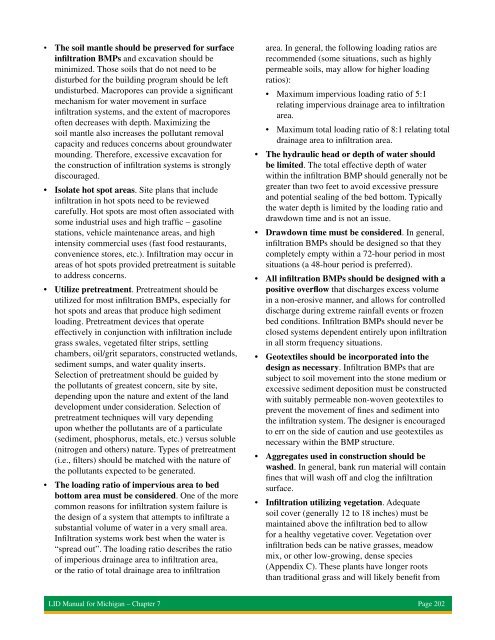Low Impact Development Manual for Michigan - OSEH - University ...
Low Impact Development Manual for Michigan - OSEH - University ...
Low Impact Development Manual for Michigan - OSEH - University ...
Create successful ePaper yourself
Turn your PDF publications into a flip-book with our unique Google optimized e-Paper software.
• The soil mantle should be preserved <strong>for</strong> surface<br />
infiltration BMPs and excavation should be<br />
minimized. Those soils that do not need to be<br />
disturbed <strong>for</strong> the building program should be left<br />
undisturbed. Macropores can provide a significant<br />
mechanism <strong>for</strong> water movement in surface<br />
infiltration systems, and the extent of macropores<br />
often decreases with depth. Maximizing the<br />
soil mantle also increases the pollutant removal<br />
capacity and reduces concerns about groundwater<br />
mounding. There<strong>for</strong>e, excessive excavation <strong>for</strong><br />
the construction of infiltration systems is strongly<br />
discouraged.<br />
• Isolate hot spot areas. Site plans that include<br />
infiltration in hot spots need to be reviewed<br />
carefully. Hot spots are most often associated with<br />
some industrial uses and high traffic – gasoline<br />
stations, vehicle maintenance areas, and high<br />
intensity commercial uses (fast food restaurants,<br />
convenience stores, etc.). Infiltration may occur in<br />
areas of hot spots provided pretreatment is suitable<br />
to address concerns.<br />
• Utilize pretreatment. Pretreatment should be<br />
utilized <strong>for</strong> most infiltration BMPs, especially <strong>for</strong><br />
hot spots and areas that produce high sediment<br />
loading. Pretreatment devices that operate<br />
effectively in conjunction with infiltration include<br />
grass swales, vegetated filter strips, settling<br />
chambers, oil/grit separators, constructed wetlands,<br />
sediment sumps, and water quality inserts.<br />
Selection of pretreatment should be guided by<br />
the pollutants of greatest concern, site by site,<br />
depending upon the nature and extent of the land<br />
development under consideration. Selection of<br />
pretreatment techniques will vary depending<br />
upon whether the pollutants are of a particulate<br />
(sediment, phosphorus, metals, etc.) versus soluble<br />
(nitrogen and others) nature. Types of pretreatment<br />
(i.e., filters) should be matched with the nature of<br />
the pollutants expected to be generated.<br />
• The loading ratio of impervious area to bed<br />
bottom area must be considered. One of the more<br />
common reasons <strong>for</strong> infiltration system failure is<br />
the design of a system that attempts to infiltrate a<br />
substantial volume of water in a very small area.<br />
Infiltration systems work best when the water is<br />
“spread out”. The loading ratio describes the ratio<br />
of imperious drainage area to infiltration area,<br />
or the ratio of total drainage area to infiltration<br />
area. In general, the following loading ratios are<br />
recommended (some situations, such as highly<br />
permeable soils, may allow <strong>for</strong> higher loading<br />
ratios):<br />
• Maximum impervious loading ratio of 5:1<br />
relating impervious drainage area to infiltration<br />
area.<br />
• Maximum total loading ratio of 8:1 relating total<br />
drainage area to infiltration area.<br />
• The hydraulic head or depth of water should<br />
be limited. The total effective depth of water<br />
within the infiltration BMP should generally not be<br />
greater than two feet to avoid excessive pressure<br />
and potential sealing of the bed bottom. Typically<br />
the water depth is limited by the loading ratio and<br />
drawdown time and is not an issue.<br />
• Drawdown time must be considered. In general,<br />
infiltration BMPs should be designed so that they<br />
completely empty within a 72-hour period in most<br />
situations (a 48-hour period is preferred).<br />
• All infiltration BMPs should be designed with a<br />
positive overflow that discharges excess volume<br />
in a non-erosive manner, and allows <strong>for</strong> controlled<br />
discharge during extreme rainfall events or frozen<br />
bed conditions. Infiltration BMPs should never be<br />
closed systems dependent entirely upon infiltration<br />
in all storm frequency situations.<br />
• Geotextiles should be incorporated into the<br />
design as necessary. Infiltration BMPs that are<br />
subject to soil movement into the stone medium or<br />
excessive sediment deposition must be constructed<br />
with suitably permeable non-woven geotextiles to<br />
prevent the movement of fines and sediment into<br />
the infiltration system. The designer is encouraged<br />
to err on the side of caution and use geotextiles as<br />
necessary within the BMP structure.<br />
• Aggregates used in construction should be<br />
washed. In general, bank run material will contain<br />
fines that will wash off and clog the infiltration<br />
surface.<br />
• Infiltration utilizing vegetation. Adequate<br />
soil cover (generally 12 to 18 inches) must be<br />
maintained above the infiltration bed to allow<br />
<strong>for</strong> a healthy vegetative cover. Vegetation over<br />
infiltration beds can be native grasses, meadow<br />
mix, or other low-growing, dense species<br />
(Appendix C). These plants have longer roots<br />
than traditional grass and will likely benefit from<br />
LID <strong>Manual</strong> <strong>for</strong> <strong>Michigan</strong> – Chapter 7 Page 202

















